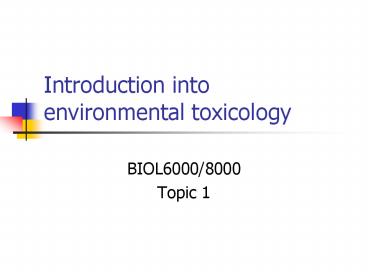Introduction into environmental toxicology - PowerPoint PPT Presentation
1 / 28
Title:
Introduction into environmental toxicology
Description:
Concept of Gaia (J. Lovelock) 1919 - For those who are interested: ... Dr James Lovelock - Gaia - A New Look at Life on Earth. Global distillation ... – PowerPoint PPT presentation
Number of Views:3833
Avg rating:3.0/5.0
Title: Introduction into environmental toxicology
1
Introduction into environmental toxicology
- BIOL6000/8000
- Topic 1
2
Introducing myself
- Dr. Inna Sokolova
- Office Woodward 381c
- Office hours by appointment
- E-mail isokolov_at_uncc.edu (preferred)
- Phone 78532
3
A brief story of my life (geographically
speaking)
4
Research interests Environmental toxicology and
ecological physiology
5
Other interests
6
Learning goals
- Course goals, outline and expectations
- Environmental Toxicology definition and
structure of the science
7
Environmental Toxicology
- The branch of toxicology concerned with the study
of toxic effects, caused by natural and synthetic
pollutants, on the biosphere and constituents of
the biosphere - Biotic constituents of the biosphere plants,
animals (including humans), microbial life
(fungi, protozoans, bacteria) - Abiotic components of the biosphere
(environmental chemistry and geochemistry of
pollutants)
8
Focus of this course
- Subject and methods of environmental toxicology
- Effects of environmental contaminants on
organisms, populations and communities - Emphasis on physiological and cellular mechanisms
of toxic action of contaminants
9
Course of study
- Introduction into env.toxicology. Scientific,
technological and practical goals of
env.toxicology. - Historical need of env.toxicology. Special topic
The environmental history of DDT and Silent
Spring - Toxicology of harmful algal blooms
- Major classes of environmental contaminants.
Uptake, biotransformation, detoxification,
elimination and accumulation of toxicants. - Bioaccumulation and biomagnification. Factors
affecting accumulation of toxicants, and trophic
transfer of contaminants in ecosystems.
10
Course of study (cont.)
- Common toxicological tests and end points.
Dose-response and time-response models in
ecotoxicology. Hormesis. - Effects of toxic mixtures. Synergism, antagonism
and additivity. - Special topic Trace metals. Classification of
metals. Bioaccumulation, sites of action,
mechanisms of toxicity. Mechanisms of uptake,
detoxification and excretion of trace metals. - Special topic Tributyltin in aquatic
environments and imposex.
11
Course of study (cont.)
- Mechanisms of toxicity of organic compounds.
Cytochrome P450 and metabolism of xenobiotics.
Multixenobiotic resistance. - Special topic Endocrine disruptors.
- Special topic Radionuclides.
- Population- and community-level consequences of
pollutants in wildlife and humans - Evolutionary adaptation to pollution and
acquisition of tolerance. - Toxicant of the Year award (based on your final
essay).
12
Course requirements
- Tests Assay and short answer
- Power Point presentation on a selected topic in
environmental toxicology 40 min - Assigned reading and in-class discussions
13
Course expectations
- Active participation
- Respectful discussion
- Tolerance
- Hard work of learning
- Patience with technical failure
- Respect for life
14
How to do well in this class
- Attend all classes
- Start learning material from the FIRST day of the
class - Check course website often
- Do all the assigned readings
- Participate in all discussions
- Recommended textbooks
- Walker, Hopkin, Sibly Peakall (1997) Principles
of ecotoxicology. Taylor Francis, London. - Newman (2001) Fundamentals of ecotoxicology.
Lewis Publishers, Boca Raton etc. - Take notes!
15
How to take notes
16
Environmental Toxicology
- A synthetic science encompassing different
geographic scales and different levels of
biological hierarchy
17
The solution to pollution is dilution?
18
Boomerang paradigm
19
Biosphere
Landscape
Ecosystem
Community
Habitat
Population
Microhabitat
Individual
Organ system Organ Tissue Cell Organelle Biomolecu
le
Phase association
Chemistry
20
HIGH
LOW
Biosphere
Ecosystem
Ecological relevance Response duration Long-term
consequences
Community
Population
Individual
Tractability Ability to assign causation Pro-activ
ity in use of knowledge
Organ system Organ Tissue Cell Organelle Biomolecu
le
HIGH
LOW
21
Increased focus on the biosphereEcologically
inspired global philosophy
- Concept of the biosphere (Vladimir Vernadsky)
1863-1945
22
Concept of the biosphere
Hydrosphere
Biosphere
Lithosphere
Atmosphere
23
NASA picture of biosphere
24
Ecologically inspired global philosophy
- Concept of Gaia (J. Lovelock)
For those who are interested http//www.kheper.au
z.com/gaia/Gaia_Hypothesis.htm
1919 -
25
Hypothesis of Gaia Earth as a superorganism
The entire range of living matter on Earth from
whales to viruses and from oaks to algae could be
regarded as constituting a single living entity
capable of maintaining the Earth's atmosphere to
suit its overall needs and endowed with faculties
and powers far beyond those of its constituent
parts Dr James Lovelock - Gaia - A New Look at
Life on Earth
26
Global distillation
PCBs, pesticides (DDT, lindane, toxaphene,
chlordane), heavy metals (Hg, Cd)
27
Chernobyl accident
Extent of a radiation cloud on April 27, 1986
(red) and on May 6, 1986 (blue)
28
Take-home messages
- Env.toxicology is a fascinating but tough subject
- Start learning material TODAY! No time for
catching up. - Lectures are vital. Recommended books are helpful
but insufficient. - Take notes! PowerPoint slides typically contain
30-50 of the information I am talking about in
the class the rest 50-70 should be written down
by you! - Good luck and I hope youll enjoy it!































